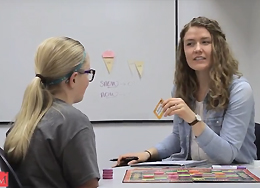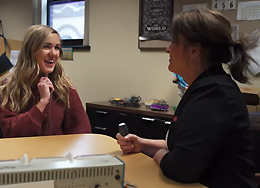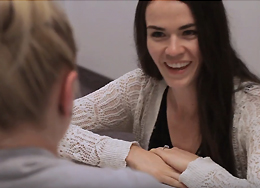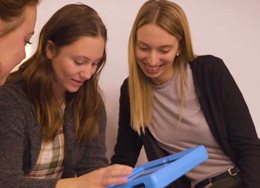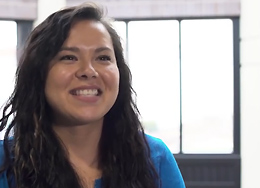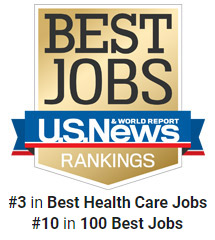Welcome
Changing Lives Through Communication
Professionals in communication sciences and disorders working as a speech-language pathologist (SLP) work with infants, children, and adults with speech, language, communication, and swallowing disorders. Our nationally recognized program is successful because of the collaboration among students, faculty, professionals, and our clients. We have a proven track record in helping our students develop knowledge of the field, but also become innovative and well-rounded professionsals through critical thinking, problem solving and self-confidence.
Program Options
Students pursuing a bachelor's degree in communication sciences and disorders are typically interested in pursuing graduate work in speech pathology or audiology.
Our post baccalaureate program is designed to help bridge the gap from current undergraduate degree to the master’s in speech language pathology program.
Graduates of the master's program become accredited speech language pathologists and most work directly with children, adolescents, or adults with a variety of speech, language, communication, cognition, and swallowing disorders in settings that include:
Schools Hospitals Clinics Private Practice Agencies
The Communication Sciences and Disorders offers the following degree options:
It takes four years to complete your 120-semester hour communication sciences and disorders major when you average 15 credits per semester. The program consists of 38 general foundational education credits, 41 communication disorders credits, and 41 related content credits. Courses within the major begin your freshman year.
Undergrad Catalog
The academic catalog is updated yearly and subject to change.
BS in Communication Sciences and Disorders Four-Year Plan
Fall 2023
When you transfer to Minot State, it is important to visit the Transfer Equivalency System at https://tes.collegesource.com/ to determine which courses will be accepted. It will also be helpful to talk with the department chair during this process.
It’s best when you transfer to Minot State with an A.A. or A.S. degree for your general education requirement to be satisfied.
When you transfer into communication sciences and disorders from another institution without general education requirements met, you may have to take an increased credit load or extend your program in order to complete the baccalaureate degree.
Undergrad catalog
The academic catalog is updated yearly and subject to change.
Are you interested in a career as a speech-language pathologist but have an undergraduate degree in something other than communication sciences and disorders?
Our post-baccalaureate program has been created with you in mind!
This program helps bridge the gap from your current undergraduate degree to the master’s program. It takes one year, on-campus, and involves 38 credit hours of courses averaging 19 hours per semester.
Admission to the program is by application. Admittance dates roll the start date to the fall semester. You will be offered an optional clinical experience the summer following completion of your post-bac year. Students who attend Minot State for the post bac program are given special consideration in the graduate admission process.
Post-Baccalaureate advising sheet
Undergrad catalog
The academic catalog is updated yearly and subject to change.
Our program has a rich history of educational and clinical excellence with a 97% Praxis pass rate and a 100% post-graduation employment rate. Students from across the country and Canada are admitted and, at the same time, we prioritize Minot State students for acceptance.
The residential program takes five consecutive full-time on campus semesters to complete. You will have required clinical experiences every semester. Admission is in the fall and your final externship will take place in the setting of your choice. We place students across the United States and Canada. Previous students have been awarded placements at prestigious sites such as the Cincinnati Children’s Hospital, Kennedy Krieger Institute, and the OHSU Doernbecher Hospital in Portland, Oregon. Our highly regarded graduates are employed across North Dakota, the United States, and Canada.
We are pleased to announce that as of Fall 2022, we will be offering an online graduate program. Once full, the online program will accept students every two years. The online program is offered part-time and takes eight consecutive online semesters to complete. Admission is in the Fall and your final externship will take place in the seventh and eighth semesters. The second summer semester requires an 8-week on-campus clinical experience.
To be considered for admission, applicants must have:
- A Bachelor degree (BS) in Communication Sciences and Disorders (CSD) or successful completion of a Post Baccalaureate program.
- A minimum 3.25 grade point average for the last four years or in the last 60 semester hours of study;
- Three letters of recommendation from academic instructors and/or supervisors (two from within the communication disorders major and one external evaluator) who can attest to the individual’s ability to work in teams, diversity experiences, and community service.
- For Statement of Purpose use this prompt: Describe your experiences that align with our program mission.
- Graduate Program UG Coursework Worksheet.
Potential students are advised of the following:
- Application deadline is January 15th.
- North Dakota students and those who have completed an undergraduate degree or post-baccalaureate program at Minot State will receive priority consideration.
- Qualified students will be rank ordered based on overall GPA, CD GPA, letters of recommendation, and statement of purpose.
- Under rare circumstances, with substantial evidence that a person’s undergraduate record does not appropriately and accurately represent a student’s abilities and promise, the Faculty may recommend and the Department Chairperson may approve the acceptance of persons who do not meet the stated minimum requirements for acceptance.
- At times, applicants are admitted on a provisional-probational basis. This admission will be considered as the single allowable semester of probation.
If a student enters the program on a full-time basis and has met ASHA requirements for the biological sciences, basic chemistry or physics, statistics, and the social/behavioral sciences, then it is possible to complete the degree in five semesters. Students will be on campus for four semesters and will complete an external practicum in their fifth semester.
Graduate catalog
The academic catalog is updated yearly and subject to change.
The Mission of the Department of Communication Sciences and Disorders is to provide entry level Speech-Language Pathology professionals who meet the needs of the state and region by:
1. Providing students with high quality educational and clinical experiences
2. Encouraging active engagement through a variety of community service and clinical experiences
3. Delivering integrated experiences that allow students the opportunity to connect theory with practice, work in teams, respect the diversity of today's world, and understand connections between research, evidence-based practice, and the therapeutic environment.
Goals of the Graduate Program in Speech Language Pathology:
1. To provide course offerings and clinical experiences reflecting pertinent and current content preparing students for personal growth and professional competence as a beginning practitioner in the field of speech language pathology.
2. To offer information and experiences in factors that foster students’ abilities to serve a diverse clientele considering cultural and social variables as well as language exposure/acquisition on clients/patients and their families.
3. To facilitate student understanding of communication, cognitive, hearing, speech, language, literacy, and swallowing development and disorders across the life span.
4. To create intellectual excitement, curiosity, and student involvement in community service and inter-professional activities as well as encourage application of research evidence into everyday clinical practice.
TUITION, SCHOLARSHIPS, & FINANCIAL AID
- A record number of scholarships are now available at Minot State.
- We are the most affordable university in the U.S. for out-of-state students.
- Our new Automatic 4-Year Academic Award is available to qualified incoming freshman.
- 57% of our students graduate with no student loan debt.
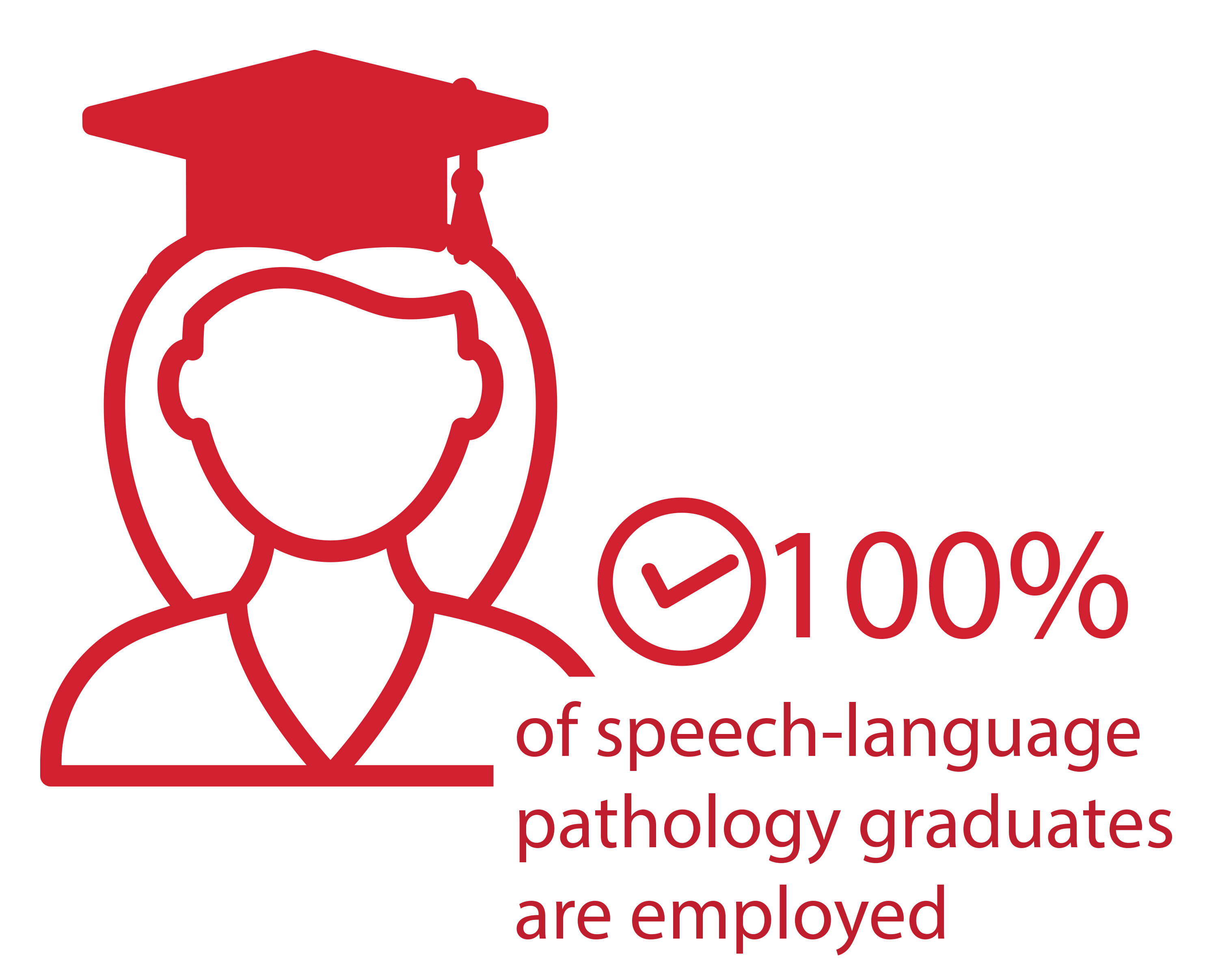
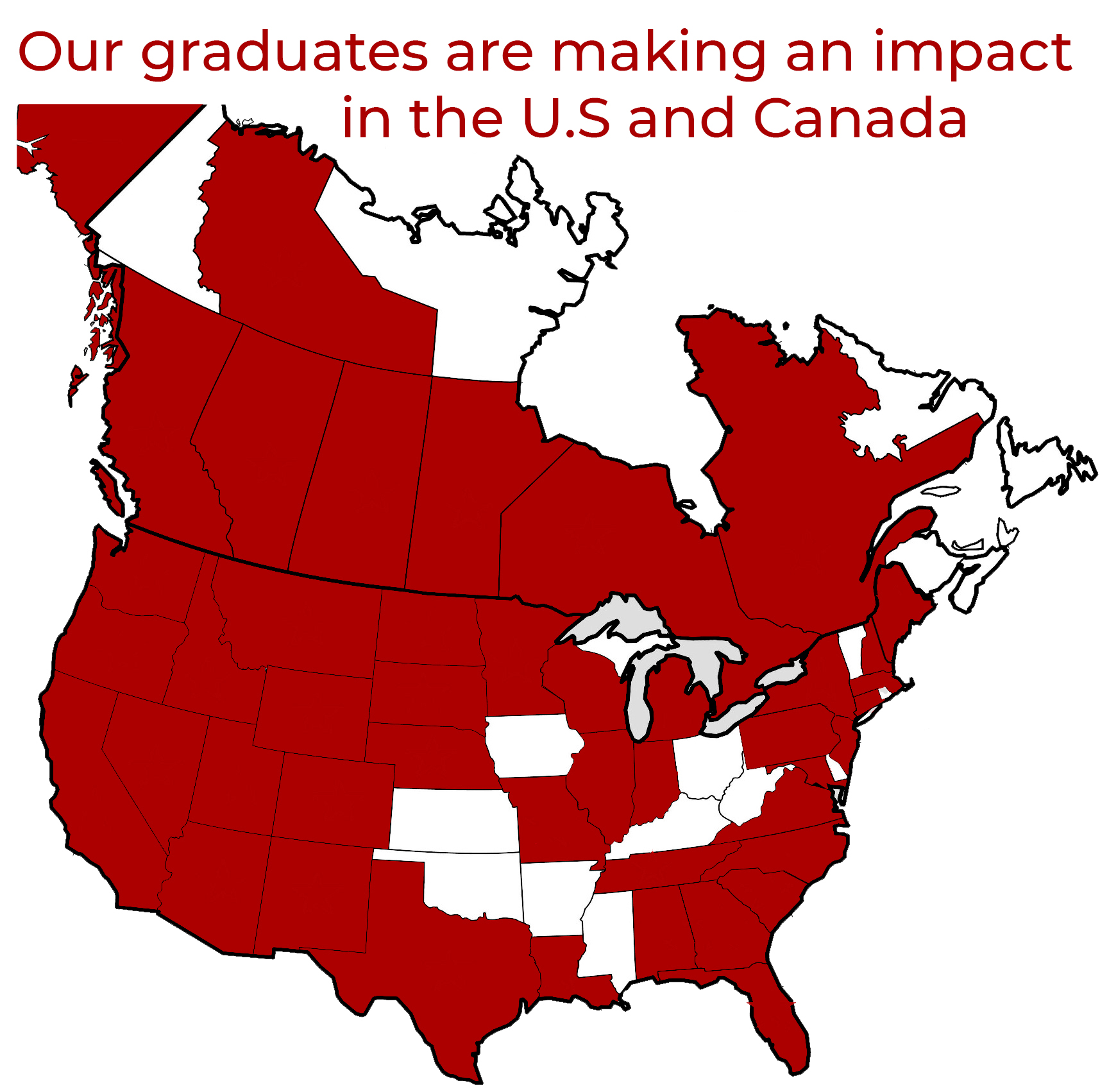
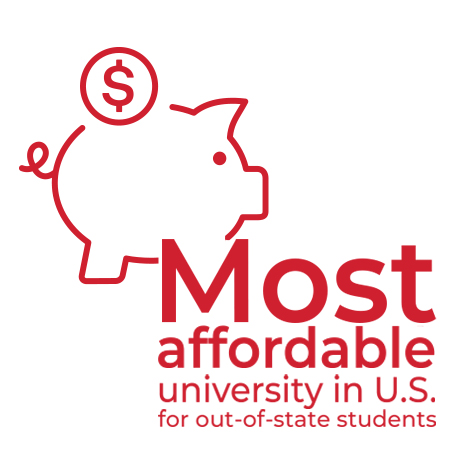
Our Mission
In line with MSU’s strategic plan, Empowering Generations, the mission of the Department of Communication Sciences and Disorders at Minot State University is to provide entry level speech-language professionals who meet the needs of the state and region by:
- Providing students with high quality educational and clinical experiences
- Encouraging active engagement through a variety of community service and clinical experiences
- Delivering integrated experiences that allow students the opportunity to connect theory with practice, work in teams, respect the diversity of today’s world, and understand connections between research, evidence-based practice, and the therapeutic environment
Vision
The vision of the Department of Communication Sciences and Disorders at Minot State University is to develop highly regarded entry level speech-language professionals who actively improve and enhance the lives of the people and communities they serve.
Mission
In line with MSU’s strategic plan, Empowering Generations, the mission of the Department of Communication Sciences and Disorders at Minot State University is to provide entry level speech-language professionals who meet the needs of the state and region by:
- Providing students with high quality educational and clinical experiences
- Encouraging active engagement through a variety of community service and clinical experiences
- Delivering integrated experiences that allow students the opportunity to connect theory with practice, work in teams, respect the diversity of today’s world, and understand connections between research, evidence-based practice, and the therapeutic environment
Goal 1
Provide a thoughtful, current, relevant, and high-quality curriculum that meets ASHA requirements and is responsive to the needs of both students and employers.
(In support of Empowering Generations, Goal 1: Excellence in Education; Offer high-quality academic opportunities to meet educational needs.)
Objective 1.1: Review & Revise Undergraduate Curriculum
- The undergraduate curriculum has undergone some major updates making it more relevant to today’s student’s interests allowing them more choice in the course they can take.
- Student learning outcomes have been rewritten allowing us to assess what students learn more readily in each area of the program.
Next Steps: *Explore development of online program
*Review the CD courses for content currency and relevance. If you have any feedback for this review please let us know via email @ mary.huston@minotstateu.edu
Objective 1.2: Review and Revise the Graduate Curriculum
- The graduate curriculum has been aligned with the 2020 ASHA standards.
- Student learning outcomes have been rewritten allowing us to assess what students learn more readily in each area of the program. Beginning this year students must complete a series of assessments as they progress through the curriculum.
Next Steps: *Review program and courses and align with emerging trends in the field.
*Explore development of online program
Goal 2
Enhance recruitment and retention of students
(In support of Empowering Generations, Goal 2: Recruit and Retain; Increase student enrollment and improve student support services and Goal 3: Retain and Graduate; Support and increase student retention and graduation.)
Objective 2.1: Recruit well-qualified undergraduate, post-baccalaureate, and graduate students.
- A Freshman Guarantee has been established allowing qualified freshman students automatic entry into the graduate program if they attend MiSU all four years and continue to meet the requirements. For more information please see our website.
- Approximately 64,000 has been endowed for CD student scholarships. If you are interested in giving back, please contact the development foundation at this link: MinotStateU.edu/alumni/give.shtml
Objective 2.2: Retain well-qualified undergraduate and graduate students.
- Careful recruitment of graduate students ensures a good retention rate
- We have instituted a student support team within the department to assist students struggling academically in our coursework
Next Steps: *Develop an exit questionnaire for students who leave the program to look for trends in attrition.
Goal 3
Enhance clinical opportunities and client diversity and explore reimbursement options (In support of Empowering Generations Goal 5; Foster and grow collaborative partnerships and community engagement.)
Objective 3.1: Develop diverse on- and off-campus clinical experiences in a variety of sites and settings with diverse clients across ASHA’s Big Nine and the lifespan.
- We have made great strides in the clinical experiences given to students in our graduate program. All receive a combination of off-campus and on-campus placements and are responsible for multiple clients in a semester.
- Clinical simulations are also part of the graduate clinical experience
- Interprofessional labs are part of clinician’s class allowing students to see clinical situations from a multitude of perspectives
Next Steps: *Explore and develop innovative hospital experiences for our students.
Objective 3.2: Enhance clinical procedures and explore reimbursement options
In line with Minot State’s commitment to community service our clinical services are now offered to the public free of charge. We are currently looking for clinic sponsors and donations are always welcome. If you care to donate please use this link: MinotStateU.edu/cd/clinic.shtml
- Positions have been reconfigured to better serve our student needs and many of our clerical tasks have been automated including use of an electronic clinical records system.
- Next Steps: *Secure sponsorship for our clinic
Goal 4
Enhance and augment program resources (In support of Empowering Generations Goal 1: Excellence in Education; Offer high-quality academic opportunities to meet educational needs; and Goal 2: Recruit and Enroll; Increase student enrollment and improve student support services.)
Objective 4.1: Secure the resources necessary to provide an excellent academic and clinical education to students
- We have completely remodeled our clinic and have updated our clinical recording system.
- The stuttering, voice, and AAC labs have been updated with the newest technology.
- A Medical Speech Pathology lab has been established
- Our students get to learn in the Cadaver Lab on campus
Next Steps: *Develop grant writing initiatives within the department to continue to enhance student academic and clinical opportunities.
Goal 5
Empower creative and engaged faculty and staff (In support of Empowering Generations Goal 6: Creative and Engaged Faculty & Staff; Support and value faculty and staff.)
Objective 5.1: Find, support, value, and retain creative and engaged faculty and staff
- Currently we have a full faculty who love to mentor students into the field of speech-language pathology. They are engaged in a multitude of departmental, campus, and community work. We also have two energetic adjunct faculty who assist us by teaching courses and providing clinical supervision. Soon we will have 5 faculty members with research doctorates. Most of our clinical faculty have recent experience in the field allowing us to meld theory with practice.
Next Steps: *Promote interdisciplinary partnerships between faculty to enhance the experience.
Accreditation
The Master of Science (M.S.) education program in Speech-Language Pathology (Residential and Distant Education) at Minot State University is accredited by the Council on Academic Accreditation in Audiology and Speech-Language Pathology of the American Speech-Language-Hearing Association, 2200 Research Boulevard #310, Rockville, Maryland 20850, 800-498-2071 or 301-296-5700.
- Residential Program: Initial accreditation was granted to the Master of Science in Speech-Language Pathology residential program at Minot State University on August 1,1970, and reaccreditation takes place on a recurring schedule.
- Reaccreditated March 1, 2020 - February 29, 2028
- Distance Education Program: Initial accreditation was granted to the Master of Science in Speech-Language Pathology distance education program at Minot State University on September 23, 2021, and reaccreditation takes place on a recurring schedule.
- Reaccreditated March 1, 2020 – February 29, 2028
Program Completion: Student Graduation Data
3 year average all modalities 94.81%
| Residential (on-campus) Program | ||
|---|---|---|
| Period | # completed program within expected time frame |
% completing within expected time frame |
| 2022-2023 | 25/26 | 96% |
| 2021-2022 | 20/23 | 87% |
| 2020 2021 | 28/28 | 100% |
| Distance Program | ||
|---|---|---|
| Period | # completed program within expected time frame |
% completing within expected time frame |
| 2022-2023 | Expected graduation May 2025 | Expected graduation May 2025 |
| 2021-2022 | Program start fall 2022 | Program start fall 2022 |
| 2020-2021 | NA | NA |
Praxis Examination Pass Rates of Graduates
3 year average all modalities 94.87%
| Residential (on-campus) Program | |||
|---|---|---|---|
| Period | # taking exam | # passed exam | pass rate (%) |
| 2022-2023 | 26 | 24 | 92.31% |
| 2021-2022 | 23 | 21 | 91% |
| 2020-2021 | 28 | 28 | 100% |
| Distance Program | |||
|---|---|---|---|
| Period | # taking exam | # passed exam | pass rate (%) |
| 2022-2023 | Expected graduation May 2025 | NA | NA |
| 2021-2022 | Program start F2022 | NA | NA |
| 2020-2021 | NA | NA | NA |


